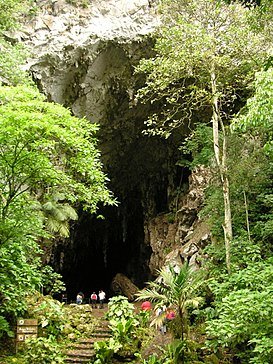
Ocupa parte de los municipios Caripe, Acosta, Piar y Bolívar (Monagas) y Ribero (Sucre). Está conformado por dos unidades o bloques separados: el de Cerro Negro, donde se ubica la Cueva del Guácharo, y el de la Cuenca Media del río Caripe. El Parque abarca 62.700 ha; las cuales se distribuyen de la siguiente forma, al sector Cerro Negro le corresponden 15.500 ha. y al de la Cuenca Media del río Caripe 47.200 ha. Fue declarado Parque Nacional El Guácharo el 27 de mayo de 1975 para garantizar la continuidad de los procesos geológicos y biológicos que se cumplen en la Cueva del Guácharo. Por su parte, el Cerro Negro, donde se localiza la Cueva del Guácharo fue el primer Monumento Natural en Venezuela el 15 de julio de 1949, con el nombre de Alejandro de Humboldt.
El guácharo
El Steatornis caripensis o guácharo es un ave frugívora que habita la primera galería de la cueva, sale en las noches en busca de su alimento. Su nombre es onomatopéyico, se deriva del quechua waqay (chillar o llorar), por su canto característico. Su color es marrón con manchas blancas y negras, una cola larga, y con cerdas alrededor del pico. Mide unos 48 cm de largo, y tienen alrededor de 91 cm de envergadura. El guácharo produce en la cueva una capa orgánica llamada guano, formada por semillas vomitadas y excrementos que constituye el nutriente básico del ecosistema de la cueva. El acontecimiento diario más importante en el parque ocurre en horas de la tarde cuando se produce la salida de las aves de la cueva en grandes bandadas, para buscar su alimento. Esta misma especie da nombre a otro parque natural: El Parque Nacional Natural Cueva de los Guácharos en la vertiente occidental de la Cordillera Oriental, en Colombia. En el entorno alejado de la cueva y en otros lugares se encuentra una gran cantidad de alimento para estas aves; particularmente importante el área de la Mata de Mango, en el sector de la Cuenca Media del Río Caripe. En el vuelo nocturno, los guácharos recorren hasta 120 km. de distancia para buscar frutas y semillas grasosas, especialmente en la estación no reproductiva, mientras que en la época de cría buscan su sustento en un radio de unos 40 km. De manera que el guácharo, abandona a diario, la cueva en busca de alimentos; lo hace por bandadas de miles de individuos. Luego regresa a digerir y a alimentar los pichones. Se calculan en el interior de la cueva aproximadamente 10.000 ejemplares.
Otros animales típicos del lugar
Existe una amplia variedad de avifauna, dentro del Parque, constituida por aproximadamente 370 especies de aves, entre las cuales se encuentran; chivi cabecigris, Fafao gargantiblanco, Pica Flores Negro, Pico de Frasco Esmeralda, entre otras. Existen además una variedad de mamíferos, como, Mono Araguato, cunaguaro, puma, báquiro cinchado, el Tapir, el venado caramerudo, entre otros.

( )
)

It occupies part of the municipalities Caripe, Acosta, Piar and Bolívar (Monagas) and Ribero (Sucre). It is made up of two separate units or blocks: Cerro Negro, where the Guácharo Cave is located, and the Middle River Basin of the Caripe River. The Park covers 62,700 ha; which are distributed as follows, the Cerro Negro sector corresponds to 15,500 ha. and that of the Middle Basin of the Caripe River 47,200 ha. It was declared El Guácharo National Park on May 27, 1975 to guarantee the continuity of the geological and biological processes that are carried out in the Cueva del Guácharo. For its part, Cerro Negro, where the Cueva del Guácharo is located, was the first Natural Monument in Venezuela on July 15, 1949, with the name of Alejandro de Humboldt.
The guacharo
The Steatornis caripensis or guácharo is a frugivorous bird that inhabits the first gallery of the cave, it goes out at night in search of its food. Its name is onomatopoeic, it is derived from Quechua waqay (scream or cry), for its characteristic song. Its color is brown with black and white spots, a long tail, and with bristles around the beak. It measures about 48 cm long, and is about 91 cm in span. The guácharo produces in the cave an organic layer called guano, formed by vomited seeds and excrement that constitutes the basic nutrient of the ecosystem of the cave. The most important daily event in the park occurs in the afternoon when the birds leave the cave in large flocks, to find their food. This same species gives name to another natural park: The Cueva de los Guácharos National Natural Park on the western slope of the Eastern Cordillera, in Colombia. In the environment away from the cave and in other places you will find a lot of food for these birds; Particularly important is the area of the Mata de Mango, in the sector of the Middle Basin of the Caripe River. In the night flight, the guácharos travel up to 120 km. away to look for fruits and greasy seeds, especially in the non-breeding season, while in the breeding season they look for their sustenance in a radius of about 40 km. So the guácharo leaves the cave every day in search of food; it does it by flocks of thousands of individuals. Then he goes back to digest and feed the chicks. About 10,000 copies are calculated inside the cave.
Other typical animals of the place
There is a wide variety of avifauna, within the Park, consisting of approximately 370 species of birds, among which are; chivi cabecigris, fafao garganiblanco, Pica Flores Black, Pico de Frasco Esmeralda, among others. There is also a variety of mammals, such as, Mono Araguato, cunaguaro, cougar, cinchona báquiro, the Tapir, the caramerudo deer, among others.


Enlaces
https://es.wikipedia.org/wiki/Parque_nacional_El_Gu%C3%A1charo